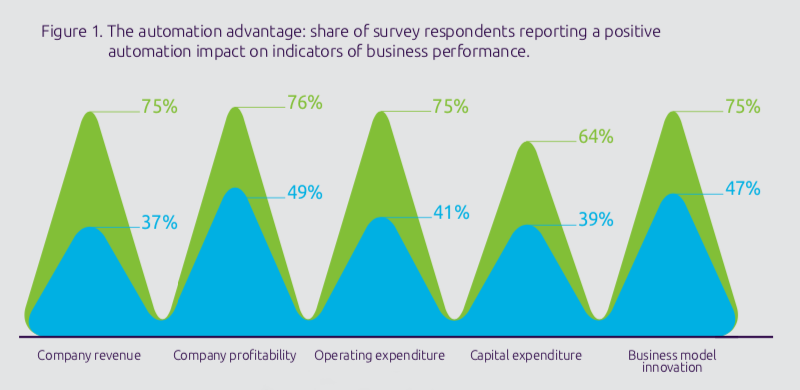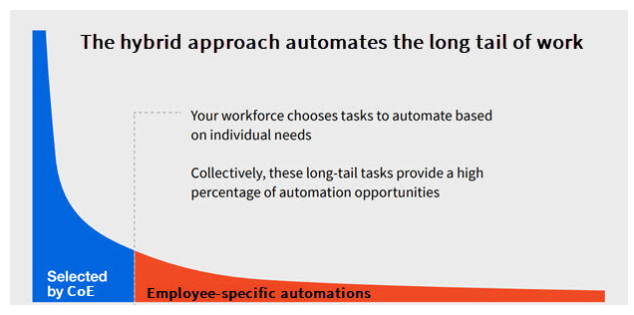The 4 Pillars of a Fully Automated Enterprise

I’m lucky to have a front-row seat to some of the highest-level automation discussions in our customers’ board rooms. The more I speak with customers, the more I hear a recurring question: “What vision should we be working towards for our automation initiatives?” Well, we’ve been working on an answer.
What we’re pursuing here is a realization of what it means for a business to operate in a world enabled by automation. What it means for companies to reach an optimal amount of automation. What we’re chasing is the fully automated enterprise™. The fully automated enterprise is the ultimate form of all the concepts our customers have been working toward.
Over the years, we have developed a number of frameworks that have helped our customers and the market process specific elements of a fully automated enterprise: 'a robot for every person,' democratization of robotic process automation (RPA), the automation flywheel. As technology has evolved—as our customers have evolved—so, too, has the vision. Every step forward has meant a subsequent, if not exponential, expansion of what we imagine is possible.
The fully automated enterprise is what happens when potential meets reality, when ambitious companies reach and grasp the future by applying automation solutions where they can make the biggest difference. It’s when back-office work becomes invisible, all employees have access to robots, and artificial intelligence (AI) suffuses and improves every process.
In this article, I’m going to break down what makes the fully automated enterprise work. There are four pillars that you can use to drive toward realizing your potential as a fully automated enterprise.
Fully automated enterprise: the what and the why
A fully automated enterprise is a company that is using automation to its fullest potential. These are companies that embrace the necessity of digital transformation and leverage it to deliver better service—from happier employees at a lower cost.
What is a fully automated enterprise?
The primary difference between a fully automated enterprise and a traditional enterprise is their approaches to automation. A fully automated enterprise takes a proactive approach to automation, and a traditional enterprise takes a reactive one. A fully automated enterprise thinks ‘automation first’ and applies automation where it makes the most sense and can have the greatest impact. A fully automated enterprise finds the right balance between what software robots do and what humans are freed up to focus on.
We sum up what a fully automated enterprise does in four pillars:
Assigns all automatable work to software robots to make back-office work invisible
Provides a robot for every person in the company
Democratizes development so that power users can quickly build new automations and applications
Applies AI to every facet of work, expanding the footprint of automation into cognitive processes to automate more
Before we get into the details, though, let’s cover the all-important question first: why?
Why should your company become a fully automated enterprise?
The reasons for fully automating are vast, but I’ve consolidated them into three data-backed categories: performance, ROI, and competitiveness.
Fully automated enterprises outcompete other companies. According to a report from Capgemini, the top-performing 20% of companies in their survey about automation are getting “considerably more” business returns than the bottom 20%. In the graph below (green indicates "fast movers" and blue indicates "followers"), you can see that these top companies report that automation has:
Led to increased revenue (75%)
Led to increased overall profitability (76%)
Helped improve the customer experience (86%)
Improved agility (84%)

Fully automated enterprises reap significant ROI. Simply put, the dollars you put into automation create more dollars coming out. SMBC, for instance, one of Japan’s leading financial institutions, has achieved $450 million in ROI from their automation investments.
Fully automated enterprises perform better. While many organizations now recognize the value of individual automation technologies, fully automated enterprises are reaping compounding benefits by combining them. Harvard Business Review found, for instance, that businesses that combine RPA and AI had a 9% average increase in revenue, whereas businesses that didn’t combine them saw only a 3% increase.
Further, in the report A Robot for Every Worker (discussed earlier today during the Reboot Work Festival), IDC found that organizations that used RPA:
Improved their speed of response, delivering shorter time to value and improving overall process efficiency (79%)
Reduced errors or mistakes, reducing time spent in rework (79%)
Increased work without hiring more headcount (74%)
Traditional enterprises won’t be able to perform as well as fully automated enterprises, and as automation evolves, the gap between the two types of companies will only grow.
The four pillars of a fully automated enterprise
These pillars are a response to real, material outcomes that we’re observing in the industry. Every component comes from conversations we’ve had with customers and trends we’ve noticed within those conversations. These pillars aren’t marketing ideals—they’re outcomes our customers have articulated and we’ve assembled into a vision everyone can strive for.
The more coherent and solid you can make that vision, the more you can garner C-suite buy in and company-wide excitement.
1. Assign automatable work to robots
In a fully automated enterprise, human employees can focus on the work they want to do and never have to do what a robot could do better.
We’re talking about the repetitive tasks that have come to dominate knowledge work over the past 50 years: data entry, data consolidation, and data processing. For decades, companies have relegated this kind of work to the back office, tasking humans with the unengaging, error-prone work of moving information from one system to another.
More work than you might imagine is ripe for automation. A McKinsey study presents two amazing stats:
In the United States (U.S.) alone, roughly 2.6 trillion hours of work a year is automatable.
Thirty percent of activities in almost two-thirds of all jobs are automatable.
A fully automated enterprise implements robots that can take over existing back-office work. The 30% of automatable activities that McKinsey cites are then automated, leaving humans to do work they’re suited for—work that’s creative, fulfilling, and valuable.
Let’s think through an example. Operating a home mortgage company usually requires asking loan officers to collect documents in order to extract information and move data from one system to another. Loan officers can spend hours verifying and inputting data instead of prospecting and working with customers.
A fully automated enterprise automates this collection, extraction, and verification work. The resulting automation is faster and free from errors, leaving employees free to do work that’s more valuable.
2. Provide a robot for every person in the company
A fully automated enterprise provides all employees with robots. With robot assistants at hand, employees can get more done while focusing on only the most valuable work.
Employees aren’t scared of automation. In the IDC report "A Robot for Every Worker," 71% of employees reported feeling optimistic about how automation would affect their daily work. Additionally, 80% of decision makers who adopted automation offered their employees the tools to help them automate their work—likely fueling that optimism.
A fully automated enterprise recognizes the desire employees have for automation and enables them to leverage the capabilities of robot assistants right from their desktops. More than the sheer provision of tools, a fully automated enterprise actually makes it easy to use those tools. Employees can then focus on their jobs instead of wrestling with technology.
This is where the automation flywheel comes into effect. The automation flywheel describes the way companies accelerate transformation. The goal is to bring automation to life faster.
Companies can accelerate the automation journey—and eventually lead to a breakthrough moment—by encouraging employees to submit automation ideas their centers of excellence (CoEs) can build. This pillar of the fully automated enterprise is all about kick-starting the automation flywheel.
For more, check out my video on the topic:

The robots a CoE provides are always there to assist and amplify the work of their employee partners. Much of this work, again, is work that humans aren’t suited to. Humans might be the best at using data, but robots are the best at putting it in the right place at the right time.
The employees who don’t directly interface with robots will at least use applications powered by robots under the hood that sit seamlessly on top of the company’s existing tech stack.
Related read: Why RPA is an Ideal Technology to Integrate Legacy Systems
Contact centers provide the perfect example of this pillar in action. A fully automated enterprise contact center will have a robot that looks up information and manages data entry while an agent talks to customers. Freed from juggling the phone and a series of disparate systems, the agent can then focus on customer service and relationship-building. This results in an agent who has more information on tap, faster, all without having to put customers on hold.
3. Democratize development
A traditional enterprise develops and hands down automations from on high. A fully automated enterprise provides low-code tools that enable all workers to quickly bring new application ideas to life from the bottom up. This leads to the breakthrough moment in the automation flywheel that I mentioned earlier: employees become citizen developers who can build their own ideas. This accelerates the flywheel even faster. That’s why UiPath is betting on the democratization of development and the rise of the citizen developer.

Traditional enterprises tend to underestimate their employees’ potential. They may doubt, for instance, that employees have the capacity, or even the interest, to operate robots. A fully automated enterprise looks at the data.
In our own survey, we found that 30% of U.S. workers wanted to learn about RPA.
A McKinsey study found that successful organizations were more likely to put the responsibility of delivering automation efforts into the hands of their functions or business units. Less successful organizations, however, were “more than twice as likely” to make a central team entirely responsible for automation delivery.
In summary, employees want to learn, and companies that give employees automation responsibilities succeed.
The potential payoff for democratization is massive. There’s a “long tail” of automation opportunities that exceed the abilities of even the best RPA teams to identify, prioritize, and handle.

A fully automated enterprise recognizes the impossibility of asking a CoE to do everything and instead gives users the ability to discover use cases and implement solutions.
The long tail is where citizen developers are going to find use cases a CoE couldn’t recognize. It’s where citizen developers shine, and these opportunities are the ones that, in aggregate, enable a fully automated enterprise to automate faster, deeper, and better than other enterprises.
Look to frontline healthcare workers for an example. In the early days of the pandemic, citizen developers working with frontline healthcare workers at Cleveland Clinic built an automation that quickly processed patient testing data across multiple systems and sped up drive-through testing. Right when it was most necessary, these innovative workers created a brand-new, mission-critical workflow.
4. Unleash AI across every facet of work
A fully automated enterprise will build smarter robots and use AI to find the best processes to automate.
AI is where a massive amount of untapped potential lies. A McKinsey study found, for example, that only 20% of companies that were aware of AI had been able to use one or more AI technologies “in a core business process or at scale.”
But for fully automated enterprises, this struggle is an opportunity, not a threat. It’s an opportunity to figure out how to leverage AI to reboot how work gets done, with the added bonus of more capacity.
So, what does AI really look like, then, in a fully automated enterprise? The driving philosophy for a fully automated enterprise is to distribute AI to every facet of the workplace in two ways:
AI helps the organization figure out what to automate. With process mining, AI can actually discover opportunities for automation that humans might have missed, helping inform a continuous system of observation and ideation.
AI adds cognitive automations that require judgments normal robots can’t provide. Robots use machine learning models or skills in real time to automate increasingly sophisticated processes, expanding the universe of automation.
This results in a fully automated enterprise that can unlock the value of AI investments by providing a vehicle for delivering AI into production environments. Data scientists—the people best able to develop new AI and machine learning models—have long struggled to access production workflows. In a fully automated enterprise, data scientists can use real-world data to inform their models and deploy those models more quickly than they could in traditional enterprises.
Let’s return back to the example I gave earlier for the home mortgage company. The fourth pillar of a fully automated enterprise drives their efforts toward helping loan officers prioritize prospects. Machine learning models use past data to predict likelihood to default, automatically giving loan officers the ability to reach out to the most important prospects first.
If you want to see more examples and learn what a fully automated enterprise looks like in action, be sure to join me and other industry experts for our UiPath Live: The Fully Automated Enterprise™ event.
Your fully automated future is on the horizon
The potential of automation is nearly limitless. Without the right framework, it's hard to concretely define what the future of automation looks like. We developed these four pillars in conjunction with our customers to give your vision of the future a shape.
With four concrete outcomes in mind, you can deliberately and steadily drive toward your future as a fully automated enterprise.
The Reboot Work Festival is all about seeing work in a new light. We’re showing—presentation by presentation, article by article—that a world of possibilities is out there for hungry, ambitious companies. If you’re one of these companies, it pays to make sure you don’t miss anything.
The fully automated enterprise is covered in great detail during the festival. Earlier today, Bobby Patrick, UiPath Chief Marketing Officer, spoke about the fully automated enterprise in detail during his keynote. Check out the recording here (available once you've registered for the Reboot Work Festival).
Update: part two of this blog series on the fully automated enterprise is now live! Read The Fully Automated Enterprise Is Here (and This Is What It Looks Like).

Chief Marketing Officer (CMO), Ada
Get articles from automation experts in your inbox
SubscribeGet articles from automation experts in your inbox
Sign up today and we'll email you the newest articles every week.
Thank you for subscribing!
Thank you for subscribing! Each week, we'll send the best automation blog posts straight to your inbox.


